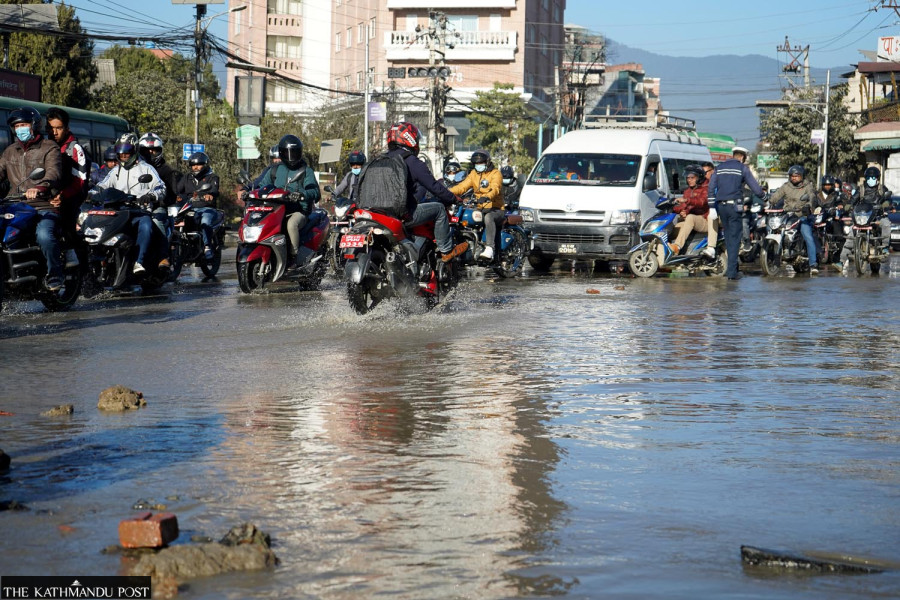Valley
Melamchi project’s pipes are leaking in many places
Leakage in water mains dampens Kathmandu Valley residents’ joy of getting long-awaited water from Sindhupalchok’s Melamchi river.
Anup Ojha
Kanchhi Maya Maharjan has been dealing with a rather unseasonable problem for the past couple of days. Her subterranean room in Bakhundole, Lalitpur has become deluged with water, rudely reminding her of peak monsoon. Maharjan, who is 62, has a three-member family who live in a single room.
The source of the flood, however, is not rain—Nepal hasn’t seen rainfall for the past four months or so—but water from the Melamchi Water project after its pipes began to burst in the area.
Maharjan said that her landlord has reported the problem to the ward office and to the Kathmandu Upatyaka Khanepani Limited, but it remains unsolved.
The pipe burst in Bakhundole has waterlogged a road section, inconveniencing at least half a dozen households and hundreds of pedestrians, who run the risk of not only getting their shoes wet but also getting their bodies splashed with dirty water by speeding vehicles.
Not only Bakhundole, over a dozen other places in Kathmandu and Lalitpur currently remain waterlogged, giving a hard time for residents and pedestrians. Authorities appear sluggish at best and indifferent at worst in solving the problem.
“The pipe burst here Saturday night,” Deepak Sharma, 30, who works at the Hermann Helmers German Bakery in Jhamsikhel, told the Post. “Now it’s like a stream of river over the road.”
Sharma said that an official at the ward office told him they would send their staff but they haven’t done that as of Sunday evening. “They really don’t care about it,” Sharma said. “Our customers are facing trouble walking through this area.”
Although many have appreciated the Melamchi Drinking Water Project for resuming water distribution during the ongoing dry spell, people are now fed up with the authority’s indifference in managing the pipelines and plugging leakages.
The Melamchi Drinking Water Project started redistributing water to households in the Valley from December 10 last year, but two months on, the project’s management and service seems poor.
Maharjan said that she was happy to know that the Melamchi dream finally came true in over two decades but now she is unhappy with the authority’s mismanagement.
“Earlier, we had to wake up at midnight to fill water jars,” Maharjan said. “We were happy when the government finally brought Melamchi water to our homes, but now the overflowing water has created another problem.”
The government started re-distributing water in the second week of December. Two days later, a pipe in the Lainchaur area burst, deluging the road and throwing traffic into a disarray. Motorcyclists, pedestrians and schoolchildren had their shoes drenched and muddied. Dozens of other water mains have burst in the Valley since.
Prakash Kumar Rai, spokesperson for the Kathmandu Upatyaka Khanepani Limited (KUKL), says the utility has repaired all the old pipelines in 1,100 places till now. He asked the Post to ask Chandra Kumar Pan Shrestha, spokesperson for Project Implementation Directorate at KUKL, about the problems in the new pipelines.
Shrestha said the problems are emerging in areas in Lalitpur, core Kathmandu, New Baneshwar, Kalanki, Balkhu and Kirtipur.
He said the Directorate has laid out new pipelines in 1,010km section within the Valley, and is currently supplying 40 million litres of water daily through old and new pipelines.
“We are doing our best to solve the problem, but we are short of manpower to fix them immediately,” Shrestha said.
He said the KUKL’s directorate has completed water testing in new pipelines in 505 km stretches such as in Anamnagar, Koteshwar, Jawalakhel, Jhamsikhel, Pulchowk, Rato Pul, Kalo Pul, Sankhamul and Kamal Pokhari areas.
Spokesperson Shrestha said the water testing drive in the remaining 505 km section remains pending, and it will take five months to solve the problems.
Further, he assured that the problems will be fixed and urged Valley’s residents to remain patient. He asked residents to contact respective ward offices and the KUKL office if they come across any water leakage in their area.
“It’s normal to have such problems because work to lay pipelines started nearly a decade ago,” he said. “Authorities such as the Department of Roads and Nepal Electricity Authority occasionally dig up the road, damaging pipelines. We are doing our best to repair them.”




 13.12°C Kathmandu
13.12°C Kathmandu.jpg)










